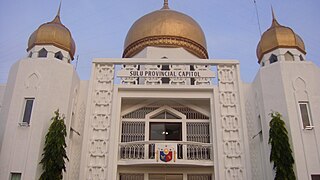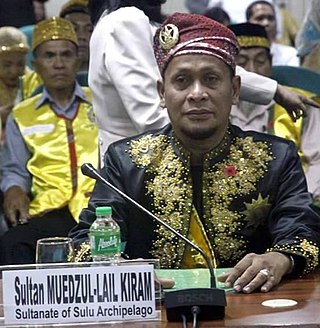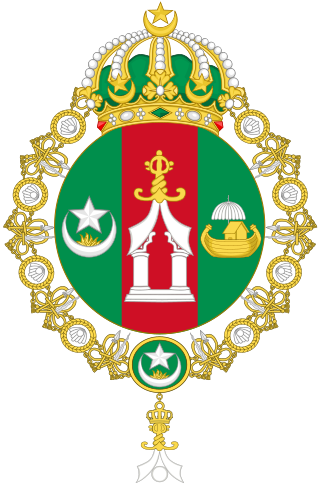| Royal House of Sulu | |
|---|---|
| Country | Sultanate of Sulu |
| Founded | 1823 |
| Founder | Sultan Jamalul Kiram I |
| Titles | Sultan of Sulu |
| Estate(s) | Royal Sulu Sultanate |
The Royal House of Sulu is an Islamic royal house which ruled the Sulu Sultanate (now part of the Philippines, Indonesia, and Malaysia). In 1962, the Philippine Government under the leadership of President Diosdado Macapagal, who himself was a distant cousin of the Sulu Sultans, counting among his ancestors Princess Laila Menchanai of Sulu, the Great Grandmother of the Muslim king of Manila, Rajah Sulayman, [1] officially recognized the continued existence of the Royal Sultanate of Sulu. [2]
On May 20, 1974, Sultan Mohammed Mahakuttah Abdullah Kiram was recognized under Memorandum Order 427, issued by then President Ferdinand Marcos, confirming the existence of the Sultanate of Sulu. Memorandum Order No. 427 states that "The Government has always recognized the Sultanate of Sulu as the legitimate claimant to the historical territories of the Republic of Philippines". [3] [4] The memorandum states that Mohammed Mahakuttah Abdullah Kiram (reigned 1974–1986) was officially the recognized Sultan of Sulu. Sultan Mahakuttah A. Kiram's eldest son Muedzul Lail Tan Kiram was crowned Sultan in a coronation event on the island of Jolo on 16 September 2012. [5] The Royal House of Kiram [6] descends from Sultan Jamalul Kiram I, who was the Sultan of Sulu from 1823 to 1844. [7] [8]
A list of the family members related to Muedzul Lail Tan Kiram is as follows: [9]

Sulu, officially the Province of Sulu, is a province of the Philippines in the Sulu Archipelago and part of the Bangsamoro Autonomous Region in Muslim Mindanao (BARMM).

The Sultanate of Sulu was a Muslim state that ruled the Sulu Archipelago, costal areas of Zamboanga City and certain portions of Palawan in the today's Philippines, alongside parts of present-day Sabah, North and East Kalimantan in north-eastern Borneo.

The Tausūg, are an ethnic group of the Philippines and Malaysia. A small population can also be found in the northern part of North Kalimantan, Indonesia. The Tausūg are part of the wider political identity of Muslim Filipinos of western Mindanao, the Sulu archipelago, and southern Palawan, collectively referred to as the Moro people. The Tausugs originally had an independent state known as the Sultanate of Sulu, which once exercised sovereignty over the present day provinces of Basilan, Palawan, Sulu, Tawi-Tawi, Zamboanga City, North Kalimantan and the eastern part of the Malaysian state of Sabah. They are also known in the Malay language as Suluk.

Butig, officially the Municipality of Butig, is a 6th class municipality in the province of Lanao del Sur, Philippines. According to the 2020 census, it has a population of 22,768 people.

The North Borneo dispute, also known as the Sabah dispute, is the territorial dispute between Malaysia and the Philippines over much of the eastern part of the state of Sabah. Sabah was previously known as North Borneo prior to the formation of the Malaysian federation.
Jamalul ibni Punjungan Kiram III was a former self-proclaimed Sultan of the Sulu Sultanate who claimed to be "the poorest sultan in the world". He was known as an unsuccessful candidate for senator in the Philippine general elections in 2007. In 2013, Kiram III sparked a controversy when he revived a dispute between the Philippines and Malaysia by leading an intrusion into the eastern part of Sabah. His daughter is Princess Jacel Kiram, a proponent of the Sabah claim of the Philippines in 2016.

Muedzul Lail Tan Kiram is the head of the Royal House of Sulu, a position which he has held since 16 February 1986. As the eldest son of the former Sultan Mohammad Mahakuttah Abdulla Kiram, he is the legitimate heir claimant to the throne of the Sultanate of Sulu. He is a pretender to the throne as the 35th Sultan of Sulu.

The Royal and Hashemite Order of the Pearl is the dynastic order of the Royal House of Sulu, which serves as the premier institution and the highest personal honour of and in the Royal Sultanate of Sulu. The order is an honourable and nobiliary corporation instituted as a dynastic Order of Datuship analogous to traditional dynastic orders of chivalry, and is in direct continuation from the ancient customs and distinctions of the Royal Sultanate of Sulu and the Court of the Sultan. Ampun Sultan Muedzul Lail Tan Kiram, as Head of the Royal House of Sulu, is the hereditary sovereign who processes the fons honorum and Grand Sayyid of the order, and his heirs and successors as heads of the Royal House of Sulu, shall ever be sovereigns and Grand Sayyids of the order.
Ismael ibni Punjungan Kiram II was a self-proclaimed Sultan of the Sultanate of Sulu from 12 March 2001 until his death on 19 September 2015.

The 2013 Lahad Datu standoff, also known as the Lahad Datu incursion or Operation Daulat, was a military conflict in Lahad Datu, Malaysia. the conflict began on 11 February, when 235 militants arrived in Lahad Datu by boat, and ended on 24 March. The militants, who called themselves the "Royal Security Forces of the Sultanate of Sulu and North Borneo", were sent by a claimant to the throne of the Sultanate of Sulu.

Datu Sadja is a senior titled nobility in the Royal Sultanate of Sulu. It is subordinate to the Datu or Su-sultanun which is acquired purely by inherited lineage or formal relationship to the Sultan. The title of Datu is roughly comparable to European sovereign princes or dukes while the title Datu Sadja can be analogous to a marquess or count. The rights of the present day customary titles are protected by a special law in the Philippines known as "The Indigenous Peoples Rights Act of 1997". This law allows traditional leadership titles to be conferred, including the title Datu, in a manner specified under the law's implementing rules and regulations which was issued as Administrative Order No. 1, Series of 1998, by the National Commission on Indigenous Peoples and written specifically under Page 11, Rule IV, Part I, Section 2, Paragraph A-C.

Sultan Mohammad Mahakuttah Abdulla Kiram was the 34th Sultan of Sulu (1974–1986). He was the eldest son of Sultan Mohammed Esmail Kiram I and the heir apparent to the throne. He was the last Sultan of Sulu officially recognised by the Philippine government.
Sultan Mohammed Esmail Kiram was a Sultan of Sulu. He ruled from 1950 to 1974.

Jamalul Kiram II was the sultan of Sulu from 1894 to 1915. During his long reign, he signed treaties with several nations. He served under both Spain and America.
Sultan Ombra Amilbangsa was a Sultan of Sulu and a Filipino politician. He also served as a member of the House of Representatives of the Philippines and the National Assembly of the Philippines for the Department of Mindanao and Sulu (1934–1935) and Sulu.
Abd ul-Bagui Butu Rasul, better known as Hadji Butu, was a Filipino statesman, politician and senator during the 4th, 6th, 7th, and 8th Philippine Legislatures, representing the 12th senatorial district.

In the Philippine history, the Lupah Sug was a predecessor state before the establishment of Sultanate of Sulu.
The Kiram–Bates Treaty, also known as the Bates Treaty, was a treaty signed by the United States and the Sultanate of Sulu during the Philippine–American War. The treaty functioned to prevent the entry of the Sulu Sultanate into the Philippine–American War while the United States concentrated its forces in northern Luzon.
Princess Tarhata Kiram was a Moro leader. She was the niece and adopted daughter of Jaramul Kiram II, Sultan of Sulu. After being educated in Manila and the United States, she returned to Jolo and married a Moro chieftain, Datu Tahil. In 1927, they staged a brief, failed rebellion against the corruption and excessive land taxation of American-supported Filipino governmental authorities. Kiram worked throughout her life to protect the economic and political rights of Muslim Filipinos.